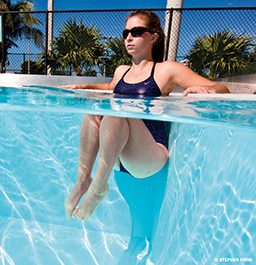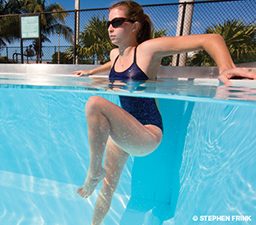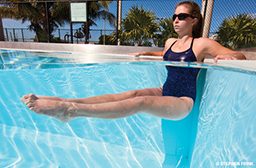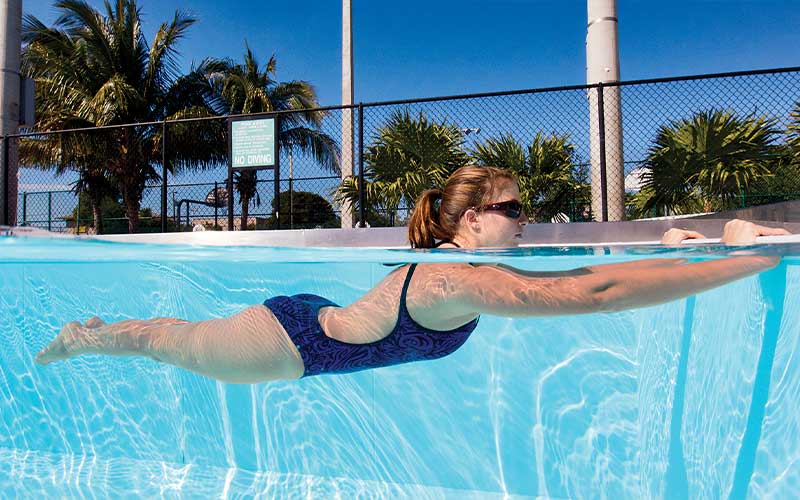Pool exercises can be beneficial to scuba divers regardless of your current level of fitness. The buoyancy water provides lessens the strain on muscles, bones and joints during exercise, which allows you to exercise through your full range of motion (ROM). An additional benefit of training in the pool is that water provides resistance in all directions.
This workout is focused on improving muscular endurance and increasing your stamina for diving; therefore, the training volume is high. It is always important to balance your workout, working the anterior muscles (on the front of your body) with an equal volume and intensity as the posterior muscles (on the back of your body). Focus on your form throughout your workout; proper form is more important than completing repetitions. Take breaks as needed, and don’t worry when you do; these breaks will decrease as your fitness improves.
Routine
5 repetitions of pool leg raises followed by
15 repetitions of pool supermans
(This is balanced because with pool leg raises, right-left-together = 1 rep)
Repeat this routine 5 times without a rest, if possible.
The high volume (with little to no rest) targets your Type I muscle fibers (endurance). The recovery for your anterior muscles occurs while you are working your posterior muscles and vice versa.
Pool Leg Raise

Pool leg raises are a modified version of the land exercise completed on hip-flexor apparatus that targets muscles on the anterior of the torso and thighs. The support of water allows even individuals with weak abdominal stabilizers to perform this exercise without back discomfort.
Targeted Muscles:
- Abdominals (primarily the rectus abdominis) contract isometrically (no change in muscle length) to stabilize a neutral spine
- Hip flexors (iliopsoas and rectus femoris) contract to mobilize hips.
Form: Position yourself at the side of the pool with arms outstretched on both sides of the pool deck. Keep your back pressed against the side of the pool. Bring your right knee as close to your chest as possible, then extend, bring your left leg as close to your chest as possible, extend and then bring both legs to your chest. This is one repetition. If you can complete more than 15 repetitions without resting, progress to the challenges identified below.
Trainer Tips:

- Your abdominals should be activated throughout the exercise. Try placing your fingertips on your abdominals during the exercise to feel the “six pack” underneath.
- Focus on bringing your knee as close to your chest as possible. Each time you do the exercise, your ROM will increase, allowing you to bring your knee closer to your chest.
- Avoid using momentum to perform the movement.
- Keep your shoulders back; supporting your body by the pool deck will force you to keep your shoulders back.
Challenge 1:
Try completing the exercise with straight legs to increase the activation of your abdominals and hip flexors. It is normal for your ROM to decrease (knee will not be as close to chest) in the straight-legged form because the muscles on the back of your legs (hamstrings) cross both your knee and hip joint. An additional benefit of completing this challenge is the improvement of hamstring flexibility; hamstrings are a commonly tight muscle group.

Challenge 2:
Start with your elbows at your sides and a portion of your forearms supporting your body weight on the pool deck. You may want to place a towel, kickboard or mat to cushion your elbows on the deck. This will isometrically activate more the stabilizing muscles of the shoulder girdle (serratus, rhomboids and lower trapezius), shoulder joint (rotator cuff) and upper arm (biceps/triceps).
Challenge 3:
Start with arms fully extended at your sides with your hands supporting your body weight to further activate the muscles of your shoulder girdle and shoulder joint.
Pool Superman

The pool superman is a modified version of the back-extension exercise on land. This exercise targets the posterior muscles of your torso and thighs, a commonly neglected area of the body. Weak lower-back muscles can be a contributor to lower-back pain. The buoyancy of water allows this exercise to be completed by individuals who have a weak lower back.
Targeted Muscles:
- Back extensors (deep erector spinae)
- Hip extensors (gluteus maximus and hamstrings: biceps femoris, semimembranosus, semitendinosus)
Form:
It is ideal to complete this exercise in water deeper than you can stand; however, it is possible to complete it in the shallow end of the pool by starting with your knees flexed (kneeling position). Hold the side of the pool, place your face near the water, and extend your torso behind you so that you are floating face down while holding the side of the pool. Return to the starting position.
Challenge 1:
Try completing this exercise with your breath. Exhale on the extension with your face in the water; lift your face and inhale on the recovery.
Challenge 2:
Try completing this exercise with fully extended legs.
© Alert Diver — Q1 Winter 2011